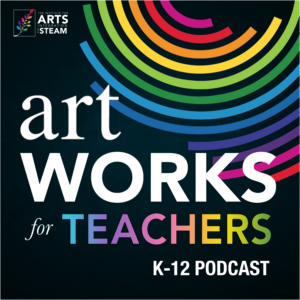ART WORKS FOR TEACHERS PODCAST | EPISODE 077 | 45:51 MIN
The Power of the Enneagram
Want to connect better with your students, team, or family? Unlock the secrets of human behavior with the Enneagram. In this episode, Susan explores the 9 personality types and how to use them to build stronger relationships.
Enjoy this free Enneagram test.
Today’s topic is something I’m so excited to chat about with you. I recently read the book The Road Back to You from Ian Morgan Cron. Maybe some of you have read it? I also took his online course that accompanies the books and I’m telling you…it’s fascinating. Basically, the book and course are all about something called the Enneagram. The Enneagram is a set of 9 classifications that help us understand human psychology on a deeper level – both for ourselves and about others.
Personally, I found this work fascinating. I could immediately begin to see which number I aligned most with and more importantly, where others in my life also fit. Soon, I started walking around my office saying things like “that’s SUCH an 8 thing to say” and “You are totally being a 9 right now”.
Now, it’s important to note that people are people, right? We’re not numbers and none of us are going to fit completely into a specific bucket. That’s the beauty of humanity. But once you know the 9 categories of the Enneagram, along with their positive and negative tendencies, you can begin to understand how you can relate with others, what you need, and what other people in your life need from you.
In the short amount of time I’ve been working with this tool, I’ve already seen such a difference in how I interact with my husband, my daughter, and my team. Which is why I wanted to share these 9 categories with you and the basics of the Enneagram. Because I think it will change how you connect, communicate, and relate to others and to yourself. So let’s dive in.
Basics of the Enneagram
At its core, the Enneagram is a personality test. We’ve all taken these kinds of tests before: Myers-Brigg, DISC, and others have given us insights into our preferences for learning, responding, and showing up in the world. So the Enneagram isn’t a novel concept. But it is different in that it helps us first become more self-aware and then how that interacts with others. The Enneagram takes into account the fluid nature of personality, which constantly adapts as circumstances change.
This helps us learn things like:
- Why people react to situations the way they do
- The communication style you should use with each member of your team or class
- How to encourage every member of your team or all students in your class in a way that truly matters
- The role that each team member or student will thrive in
- How to create common ground among colleagues or those you’re in relationship with and
- How you can reduce conflict
As we move through each of the Enneagram types, consider how these traits show up in your own life on both sides of that coin.
Enneagram Types
So let’s go over the 9 Enneagram types. Remember: we’re not pigeonholing anyone here. These are broad brushstrokes. So you probably won’t fit exclusively into one type or another. But try to determine which type MOST sounds like you OR if you can imagine someone in your life who would fit into that type. This will help you visualize how each type can interact. For each of these, I dive deeper in today’s episode about how to work with each type and what to do if you are the type discussed.
Type 1: The Reformer/Perfectionist
These folks are Principled, Purposeful, Self-Controlled, and Perfectionistic. They see a never-ending need to perfect themselves, others, and the world. They love to teach other people how to do things the right way, and often say “if I want it done right, I’ll need to do it myself.”
Type 1s also tend to have an underlying feeling of anger or resentment towards others, but they are constantly trying to make things better. They are sticklers for getting things done on time or before. They also live with the world’s worst critic: themselves. Often, 1s beat themselves up for even the tiniest little mistake.
Type 2: The Helper
Types 2s are Caring, Demonstrative, Generous, People-Pleasing, and Possessive. They are positive and people-oriented – these are the folks who know how everyone else is doing. They love to help and offer advice. But they also have a tendency to put everyone else first.
Type 3: The Achiever/Performer
Type 3s are the typical Type A personalities. These folks are success-oriented, adaptive, driven, and image-conscious. They believe that their value is in their achievements. These folks are also extremely resilient, have big dreams, and are often called work-aholics. They have an inner desire to always succeed and avoid failure at any cost. Often, these people will complete twice the work in half the amount of time it would take anyone else.
Type 4: The Individualist/Romantic
These are the most creative people on the Enneagram. They feel things deeply and connect to the world through their feelings. These people are very expressive, dramatic, and can be self-absorbed and tempermental. They also bring a lot of out-of-the-box thinking to the table, which is why many artists are a strong Type 4. They value being unique and special and respond positively anytime they can shine.
Type 5: The Investigator
If 4s are the most creative on the Enneagram, 5s are the most practical. These are intense, perceptive, innovative, secretive, and isolated people who like to live mostly in their mind. They are very cerebral about decisions and tend to over-think things. These people hate working on teams or doing groupwork. They also tend to have a scarcity mindset and will hoard things, including time, money, love, knowledge, privacy, affection, material possessions, or thoughts. More than anything, 5s are afraid of looking foolish in front of others or as though they don’t have all the answers. So they will often push down their feelings or thoughts rather than experiencing them fully.
Type 6: The Loyalist
Type 6s have a deep seated need for security. They are engaging, responsible, anxious, and often referred to as “worrywarts”. But the best part of 6s is that they will keep you safe. They are the ones who see the possible dangers of a situation, problem, or solution and bring that to our attention. They are driven by an inner need to be secure at all times. They often times play “Devil’s Advocate” which can drive others crazy, but is helpful for seeing all sides of an issue. 6s also have a tendency to take on too much work and then get overly stressed because it all seems overwhelming.
Type 7: The Enthusiast
7s are the “feel good people” on the Enneagram. Ian calls them “joy bombs”. These individuals are the busy, fun-Loving type: they are spontaneous, versatile, distractible, and scattered. They have boundless energy, default to optimism, and live for pleasure. They make great team players, make friends wherever they go, and love moving at a fast pace.
Type 8: The Challenger
Challengers operate at a different vibrational level than anyone else. Type 8s are a powerful, dominating type: they are self-confident, decisive,willful, and confrontational. When they step into a room, it’s as if they suck up all the energy and it flows like a power surge from their fingertips. This intensity can be intimidating to others, and this type is often mistakenly called a bully. But if you were to tell an 8 they were being a bully, they would be shocked. They would think they are just being straightforward and honest. 8s hate to feel like they need to be taken care of, or that they are weak. But they will always advocate for others they think cannot fight for themselves.
Type 9: The Peacemaker
Our final type is named The Peacemaker because they are easygoing, receptive, reassuring, agreeable, and complacent. These people just want everyone to get along, and they are willing to sacrifice their own happiness to do so. They want to avoid conflict and maintain connections as much as possible. They also seem to move more slowly – so others mistakenly accuse them of being lazy. But in reality, 9s are just taking their time and appreciating the moment. 9s sometimes need to zone out when the world becomes too much, and that might look like playing a video game, flipping through TV channels, or scrolling social media. What they’re really looking for is a way to relax, but they are willing to accept a cheap imitation of this when true relaxation isn’t possible or available.
How Do We Put This to Work?
Now that you know the basics of the Enneagram and a big broad overview of each type, what comes next? Well, since this is a personality test that helps you to know yourself better, I’d recommend starting with taking the actual test to find your type. When you do this, you’ll most likely get your top 3. That’s because we’re not all one type. You’ll have characteristics from several types that blend to make your unique mix.
Once you know your general type, you can begin to think about how you approach situations, conflicts, and even happy moments in your life. Just start watching yourself and your reactions. This is powerful because you can see how you behave in both a healthy and an unhealthy fashion. It reveals ways you can continue to grow and get better. And as teachers and leaders, it helps us understand how we can relate to our students and staff in more meaningful ways.
From there, you can begin to use your understanding of the 9 types to recognize trigger behaviors in others. So the next time you are met with a difficult conversation or person, take a step back and think about what traits you’re seeing rise to the top. Then, take a look at what that person’s personality type might need in order to feel seen and heard.
Like I said, the Enneagram has changed how I approach my relationships with students, staff, my family, and myself. If you’re looking for more information or to dive deeper into this concept yourself, be sure to visit the site today at artsintegration.com/sparkchasers for links to books, courses, and a free Enneagram test you can take. I hope that today’s overview has given you some tools to help chase the spark of relationship building in your own life. That’s it for today – I can’t wait to chat with you again soon.









